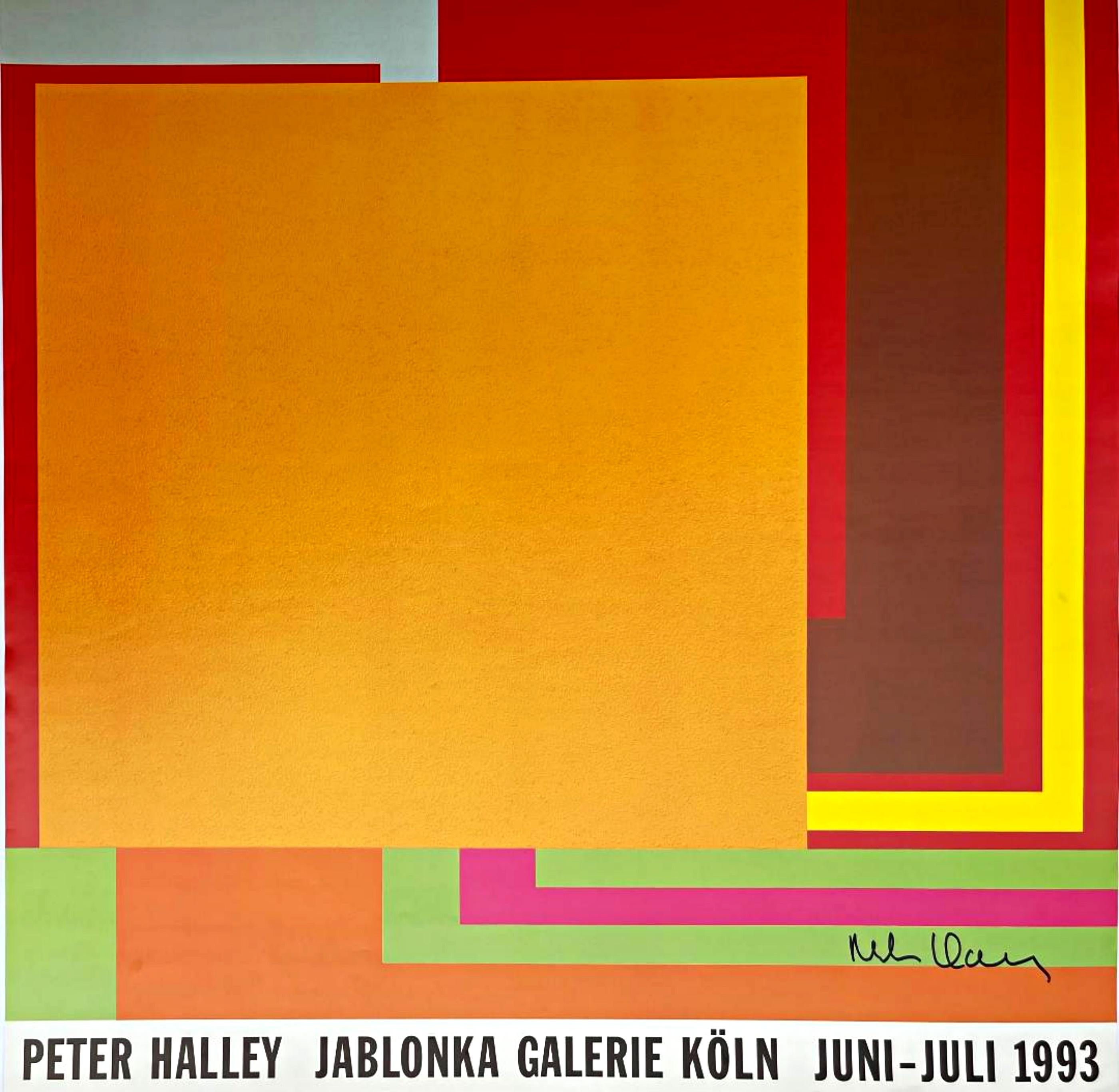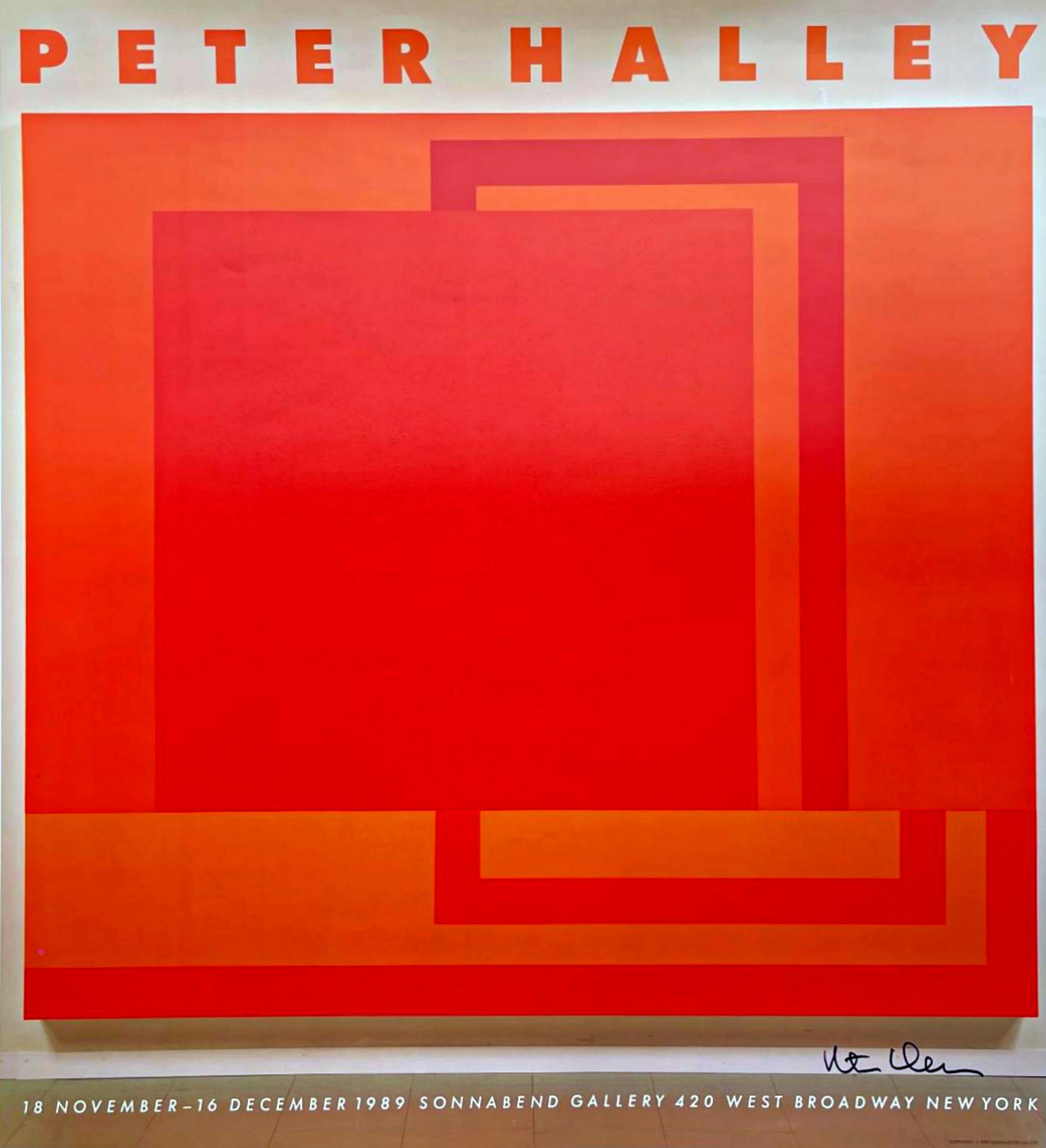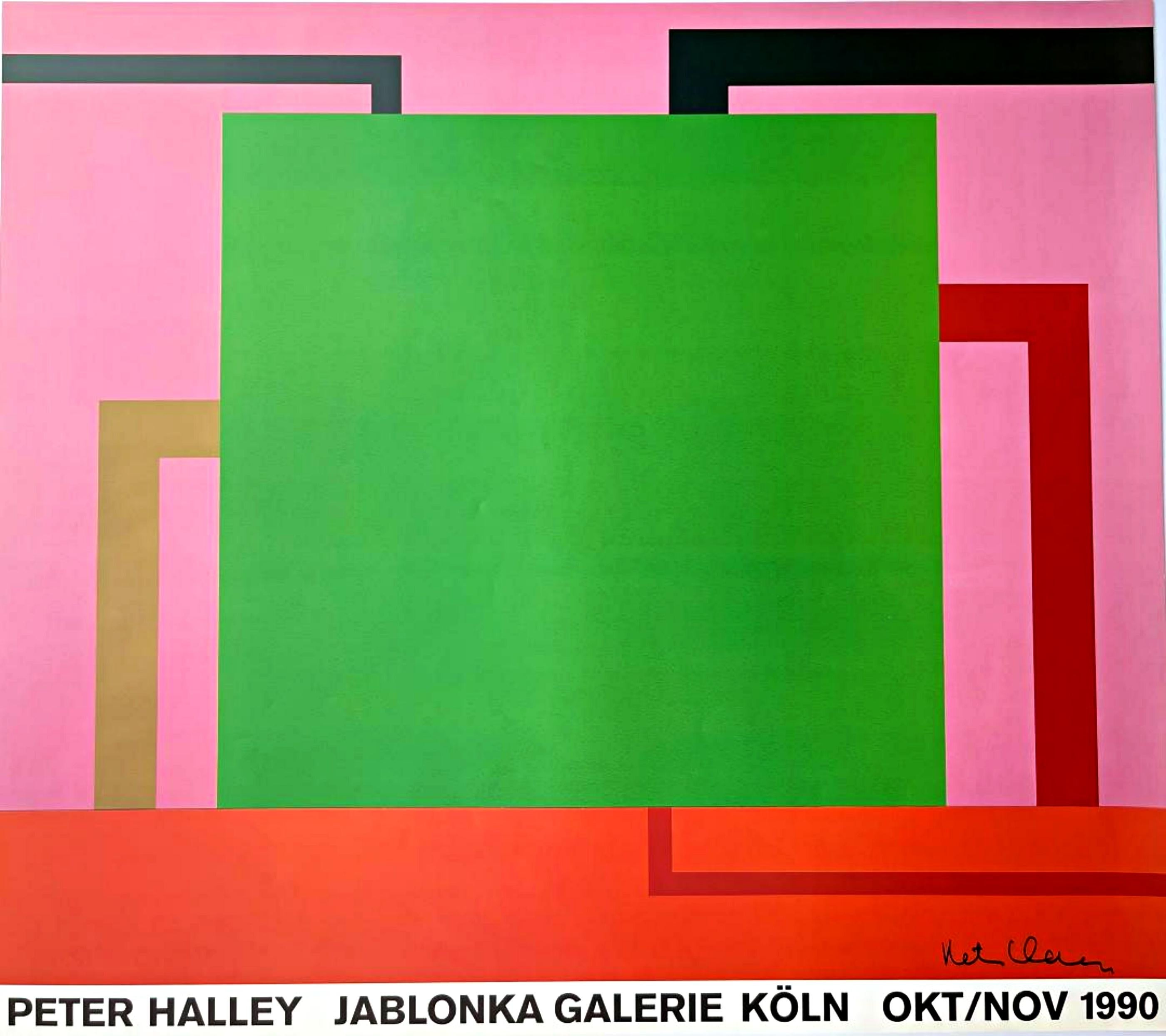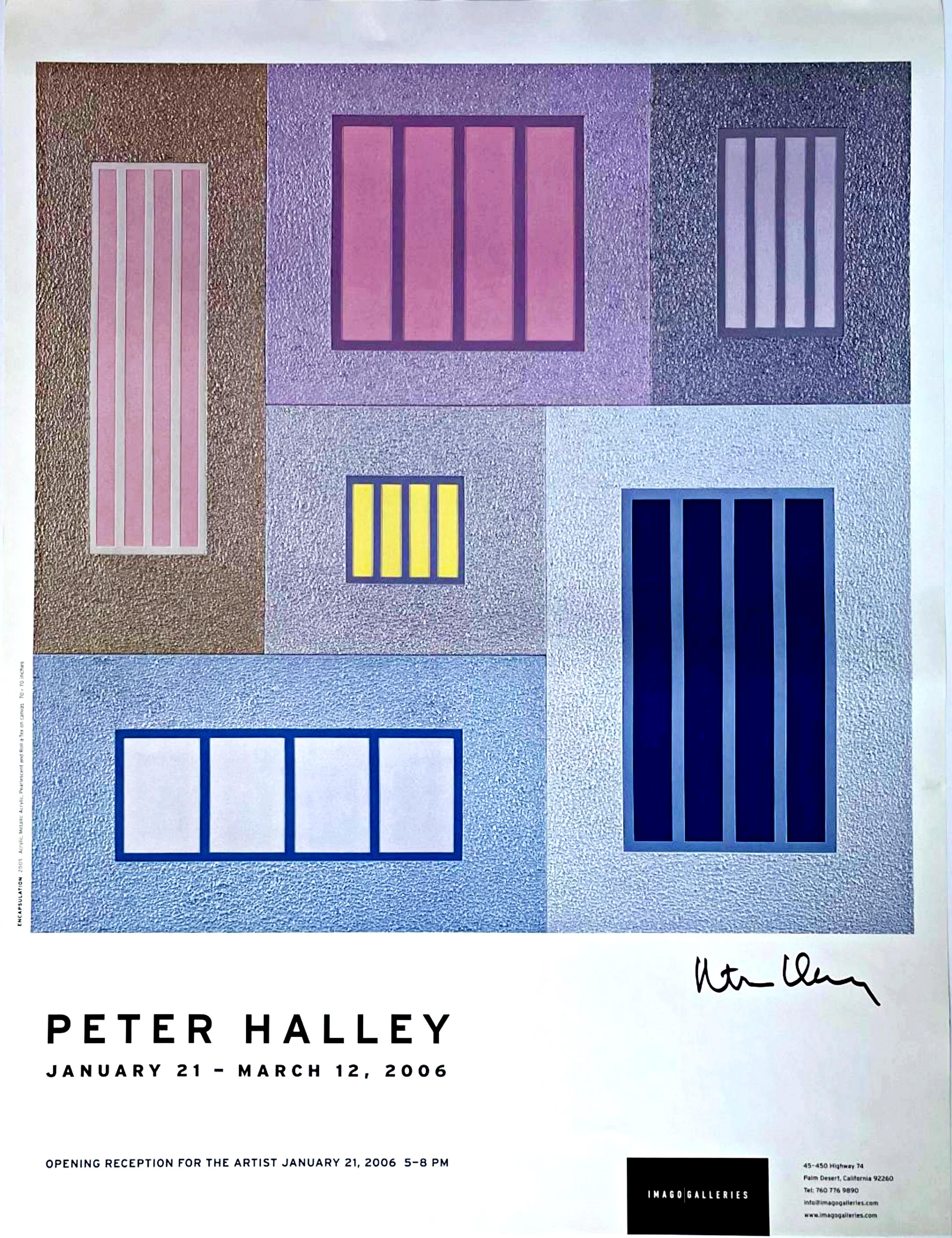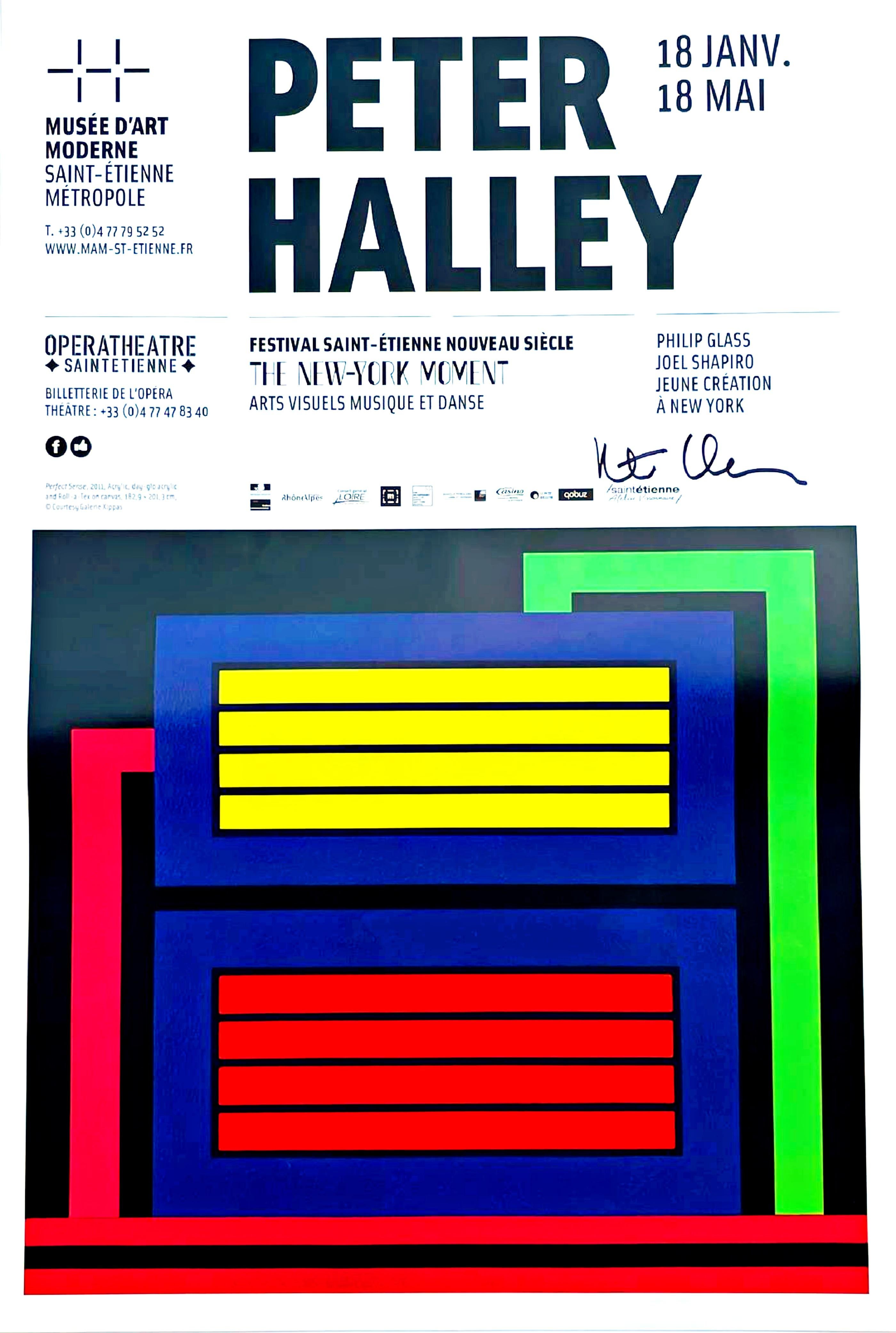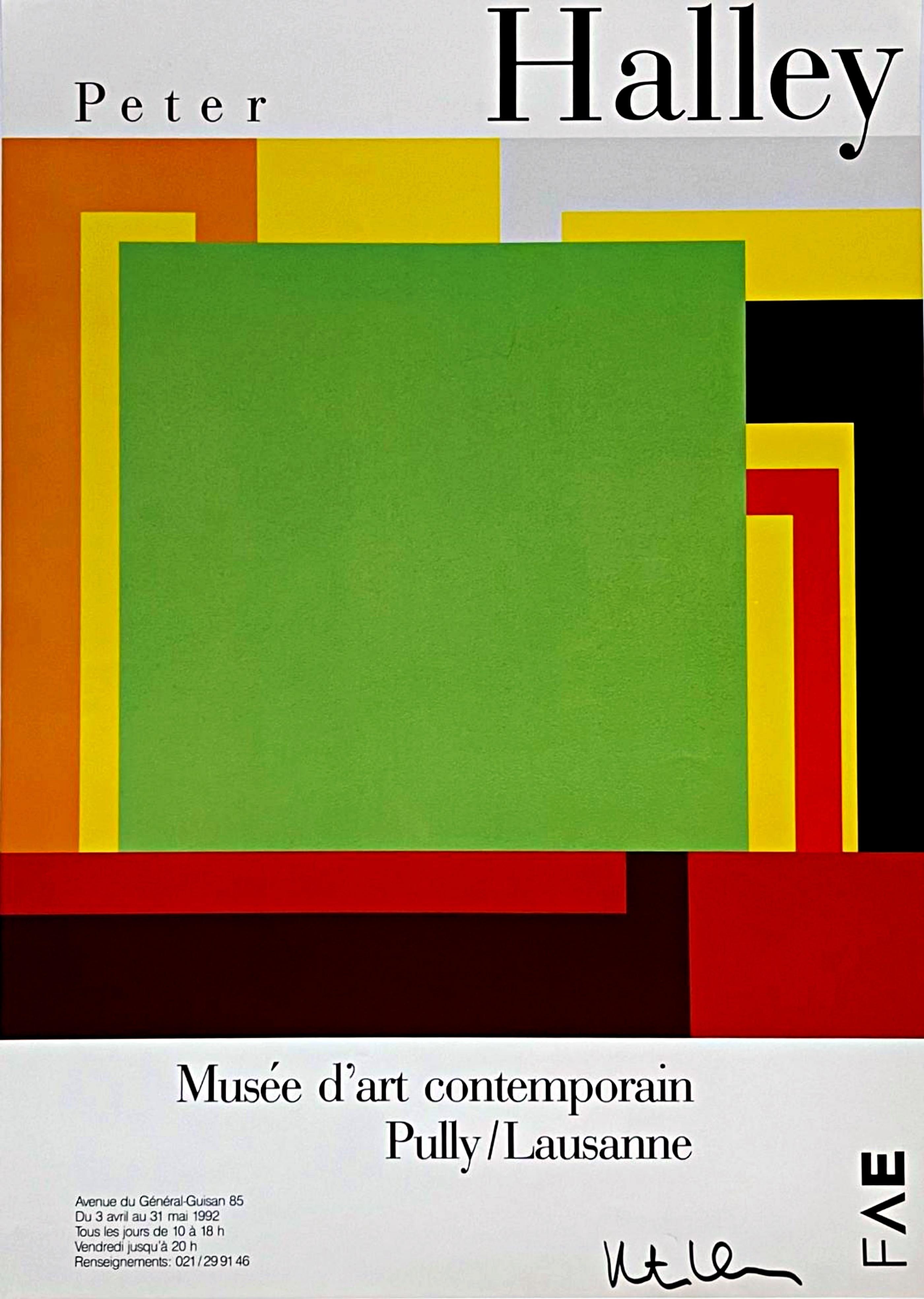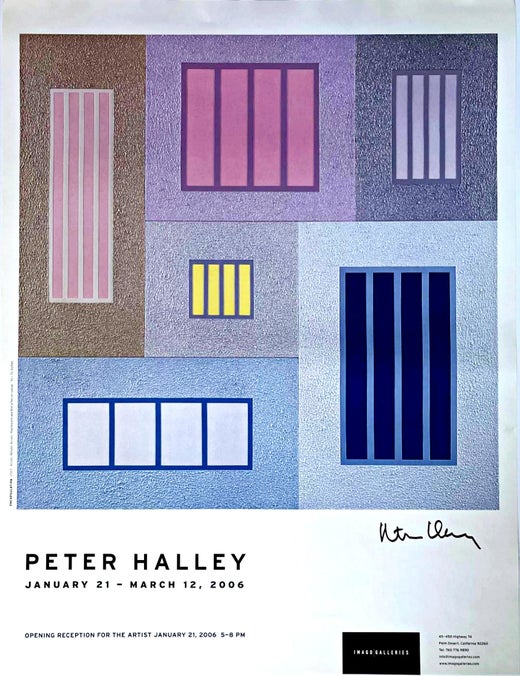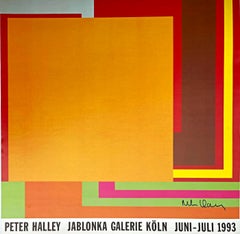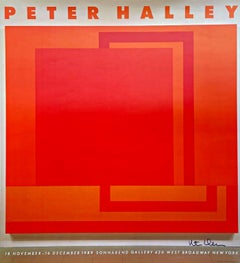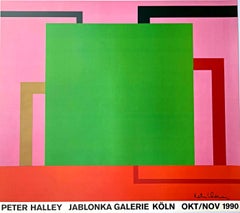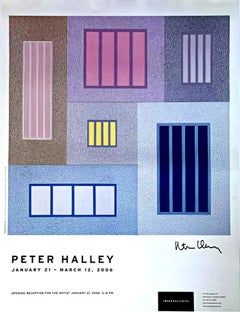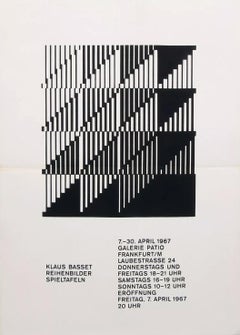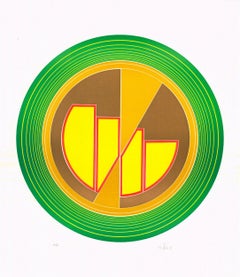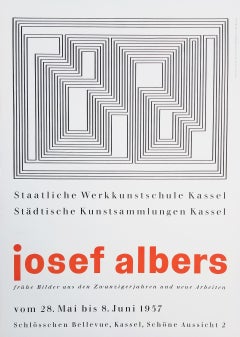Items Similar to Museum of Folkwang, Essen, Germany rare poster (Hand Signed by Peter Halley)
Want more images or videos?
Request additional images or videos from the seller
1 of 9
Peter HalleyMuseum of Folkwang, Essen, Germany rare poster (Hand Signed by Peter Halley)1998
1998
$1,000
£765.66
€877.20
CA$1,426.96
A$1,561.78
CHF 811.82
MX$18,796.61
NOK 10,205.90
SEK 9,573.45
DKK 6,552.14
About the Item
Peter Halley
Museum of Folkwang, Essen, Germany (Hand Signed by Peter Halley), 1998
Offset lithograph poster (hand signed by Peter Halley)
33 × 24 inches
Unframed
Alpha 137 Gallery is honored to offer this historic offset lithograph of legendary American artist Peter Halley's 1998- exhibition at the Museum of Folkwang, Essen, Germany,which the artist hand signed in black marker. Shown here is a photograph of our director Nadine Witkin with the artist.
Below is Peter Halley's official biography. What it doesn't mention is that Andy Warhol famously painted his portrait in 1986! Peter Halley is that legendary. According to Halley, he didn't realize until after Warhol's death that the polaroids Warhol took of him with his famous "big shot" camera were made into an original painting. Warhol's painting of Peter Halley was included in the recent Andy Warhol retrospective "Andy Warhol - from A to B and Back Again" at the Whitney.
PETER HALLEY BIOGRAPHY
Peter Halley, born 1953, New York City, is an American artist who came to prominence as a central figure of the Neo-Conceptualist movement of the 1980s. His paintings redeploy the language of geometric abstraction to explore the organization of social space in the digital era.
Since the 1980s, Halley’s lexicon has included three elements: “prisons” and “cells,” connected by “conduits,” which are used in his paintings to explore the technologically determined space and pathways that regulate daily life. Using fluorescent color and Roll-a-Tex, a commercial paint additive that provides readymade texture, Halley embraces materials that are anti-naturalistic and commercially manufactured.
In the mid 1990s Halley pioneered the use of wall-sized digital prints in his site-specific installations. He has executed installations at Museo Nivola, Orani, Sardinia (2021); Greene Naftali, New York (2019); Venice Biennale (2019); Lever House, New York (2018); Schirn Kunsthalle, Frankfurt (2016); Disjecta, Portland (2012); the Gallatin School, New York University, (2008, 2017); the Museum of Modern Art, New York (1997); and the Dallas Museum of Art (1995). In 2005, Halley was also commissioned to create a monumental painting for Terminal D at the Dallas/Fort Worth International Airport, Texas.
Halley served as professor and director of the MFA painting program at the Yale School of Art from 2002 to 2011. From 1996 to 2005, Halley published INDEX Magazine, which featured interviews with figures working in a variety of creative fields. Halley is also known for his essays on art and culture, written in the 1980s and 1990s, in which he explores themes from French critical theory and the impact of burgeoning digital technology. His Selected Essays, 1981 – 2001, was published by Edgewise Press, New York, in 2013.Halley’s writings have been translated into Spanish, French, and Italian.
A catalogue raisonné, PETER HALLEY: Paintings of the 1980s, was published in 2018 by JRP Ringier.
Halley’s work can be found in the collections of the Museum of Modern Art, New York; Whitney Museum of American Art, New York; Solomon R. Guggenheim Museum, New York; Broad Art Foundation, Los Angeles; Museum of Contemporary Art, Los Angeles; San Francisco Museum of Modern Art; Boston Museum of Fine Arts; Dallas Museum of Art; Albright-Knox Art Gallery, Buffalo; Tate Modern, London; Stedelijk Museum, Amsterdam; Sammlung Marx, Berlin; Museo Nacional Centro de Arte Reina Sofia, Madrid; Museum of Contemporary Art, Tokyo; Seoul Museum of Art, among others.
- Creator:Peter Halley (1953, American)
- Creation Year:1998
- Dimensions:Height: 33 in (83.82 cm)Width: 24 in (60.96 cm)
- Medium:
- Movement & Style:
- Period:
- Condition:A bright impression, minor handling with original folds as issued and minor paper loss along the folds (see photos) otherwise very good.
- Gallery Location:New York, NY
- Reference Number:1stDibs: LU1745210915752
Peter Halley
Peter Halley is an American artist known for his distinctive geometric paintings that explore the intersection of technology, society, and architecture. Born in 1953 in New York City, Halley developed an early interest in art and went on to study at Yale University, where he received his Master of Fine Arts degree in 1978.Halley's work is characterized by vibrant, flat colors and repetitive, abstract forms, often resembling circuit boards or prison cells. His paintings reflect his fascination with the effects of technology on human interaction and the isolation of modern society. Halley coined the term "prison cells" to describe the confined spaces and social structures that he believes have been created by technology and urban architecture. Throughout his career, Halley has exhibited his work internationally, gaining recognition for his unique style and thought-provoking concepts. He has also been involved in art criticism and writing, contributing to various publications and expanding the discourse on contemporary art. Today, Peter Halley's art continues to captivate audiences, provoking discussions about the impact of technology on our lives and the nature of human connections in an increasingly digital world. His contributions have made him an influential figure in the field of contemporary art.
About the Seller
5.0
Gold Seller
Premium sellers maintaining a 4.3+ rating and 24-hour response times
Established in 2007
1stDibs seller since 2022
458 sales on 1stDibs
Typical response time: 2 hours
- ShippingRetrieving quote...Shipping from: New York, NY
- Return Policy
Authenticity Guarantee
In the unlikely event there’s an issue with an item’s authenticity, contact us within 1 year for a full refund. DetailsMoney-Back Guarantee
If your item is not as described, is damaged in transit, or does not arrive, contact us within 7 days for a full refund. Details24-Hour Cancellation
You have a 24-hour grace period in which to reconsider your purchase, with no questions asked.Vetted Professional Sellers
Our world-class sellers must adhere to strict standards for service and quality, maintaining the integrity of our listings.Price-Match Guarantee
If you find that a seller listed the same item for a lower price elsewhere, we’ll match it.Trusted Global Delivery
Our best-in-class carrier network provides specialized shipping options worldwide, including custom delivery.More From This Seller
View AllJablonka Galerie exhibition poster, Köln (Hand Signed by Peter Halley)
By Peter Halley
Located in New York, NY
Peter Halley, Jablonka Galerie, Köln (Hand Signed), 1993
Offset lithograph poster (hand signed by Peter Halley)
26 1/2 × 26 1/2 inches
Unframed
Alpha 137 Gallery is honored to offer ...
Category
1990s Abstract Geometric Abstract Prints
Materials
Offset, Lithograph
Peter Halley at Sonnabend Gallery poster, New York (Hand Signed by Peter Halley)
By Peter Halley
Located in New York, NY
Peter Halley
Peter Halley, Sonnabend Gallery, New York (Hand Signed by Peter Halley), 1989
Offset lithograph poster (hand signed by Peter Halley)
28 × 26 inches
Unframed
Alpha 137 Gallery is honored to offer this historic offset lithograph of American artist Peter Halley's 1989 exhibition at the legendary Sonnabend Gallery in New York which the artist hand signed in black marker.
Scroll down for a photograph of our director Nadine Witkin with the artist.
Below is Peter Halley's official biography. What it doesn't mention is that Andy Warhol famously painted his portrait in 1986! Peter Halley is that legendary. According to Halley, he didn't realize until after Warhol's death that the polaroids Warhol took of him with his famous "big shot" camera were made into an original painting. Warhol's painting of Peter Halley was included in the recent Andy Warhol retrospective "Andy Warhol - from A to B and Back Again" at the Whitney.
PETER HALLEY BIOGRAPHY
Peter Halley, born 1953, New York City, is an American artist who came to prominence as a central figure of the Neo-Conceptualist movement of the 1980s. His paintings redeploy the language of geometric abstraction to explore the organization of social space in the digital era.
Since the 1980s, Halley’s lexicon has included three elements: “prisons” and “cells,” connected by “conduits,” which are used in his paintings to explore the technologically determined space and pathways that regulate daily life. Using fluorescent color and Roll-a-Tex, a commercial paint additive that provides readymade texture, Halley embraces materials that are anti-naturalistic and commercially manufactured.
In the mid 1990s Halley pioneered the use of wall-sized digital prints in his site-specific installations. He has executed installations at Museo Nivola, Orani, Sardinia (2021); Greene Naftali...
Category
1980s Abstract Geometric Abstract Prints
Materials
Offset, Lithograph
Peter Halley, Jablonka Galerie Köln rare abstract exhibition print (Hand Signed)
By Peter Halley
Located in New York, NY
Peter Halley
Jablonka Galerie, Köln (Hand Signed), 1990
Offset lithograph (Hand Signed by Peter Halley)
26 1/2 × 30 inches (ships rolled in a tube 37 x 6 x 6)
Signed by Peter Halley ...
Category
1990s Abstract Geometric Abstract Prints
Materials
Lithograph, Offset, Permanent Marker
Imago Galleries exhibition poster, Palm Desert, CA (Hand Signed by Peter Halley)
By Peter Halley
Located in New York, NY
Peter Halley
Peter Halley, Imago Galleries, Palm Desert, CA (Hand Signed), 2006
Offset lithograph poster (hand signed by Peter Halley)
25 1/2 × 18 1/4 inches
Provenance; Acquired directly from the artist
Unframed
Alpha 137 Gallery is honored to offer this offset lithograph, published on the occasion of legendary American artist Peter Halley's 2006 one-man exhibition at Imago Galleries, Palm Desert, California which the artist hand signed in black marker. Scroll images for a photograph of our director Nadine Witkin with the artist. Below is Peter Halley's official biography. What it doesn't mention is that Andy Warhol famously painted his portrait in 1986! Peter Halley is that legendary. According to Halley, he didn't realize until after Warhol's death that the polaroids Warhol took of him with his famous "big shot" camera were made into an original painting. Warhol's painting of Peter Halley was included in the recent Andy Warhol retrospective "Andy Warhol - from A to B and Back Again" at the Whitney.
PETER HALLEY BIOGRAPHY
Peter Halley, born 1953, New York City, is an American artist who came to prominence as a central figure of the Neo-Conceptualist movement of the 1980s. His paintings redeploy the language of geometric abstraction to explore the organization of social space in the digital era.
Since the 1980s, Halley’s lexicon has included three elements: “prisons” and “cells,” connected by “conduits,” which are used in his paintings to explore the technologically determined space and pathways that regulate daily life. Using fluorescent color and Roll-a-Tex, a commercial paint additive that provides readymade texture, Halley embraces materials that are anti-naturalistic and commercially manufactured.
In the mid 1990s Halley pioneered the use of wall-sized digital prints in his site-specific installations. He has executed installations at Museo Nivola, Orani, Sardinia (2021); Greene Naftali, New York (2019); Venice Biennale (2019); Lever House, New York (2018); Schirn Kunsthalle, Frankfurt (2016); Disjecta, Portland (2012); the Gallatin School, New York University, (2008, 2017); the Museum of Modern Art, New York (1997); and the Dallas Museum of Art (1995). In 2005, Halley was also commissioned to create a monumental painting for Terminal D at the Dallas/Fort Worth International Airport, Texas.
Halley served as professor and director of the MFA painting program at the Yale School of Art from 2002 to 2011. From 1996 to 2005, Halley published INDEX Magazine, which featured interviews with figures working in a variety of creative fields. Halley is also known for his essays on art and culture, written in the 1980s and 1990s, in which he explores themes from French critical theory and the impact of burgeoning digital technology. His Selected Essays, 1981 – 2001, was published by Edgewise Press, New York, in 2013.Halley’s writings have been translated into Spanish, French, and Italian.
A catalogue raisonné, PETER HALLEY: Paintings of the 1980s, was published in 2018 by JRP Ringier.
Halley’s work can be found in the collections of the Museum of Modern Art, New York; Whitney Museum of American Art, New York; Solomon R. Guggenheim Museum, New York; Broad Art Foundation, Los Angeles; Museum of Contemporary Art, Los Angeles; San Francisco Museum of Modern Art; Boston Museum of Fine Arts; Dallas Museum of Art; Albright-Knox Art Gallery, Buffalo; Tate Modern, London; Stedelijk Museum, Amsterdam; Sammlung Marx, Berlin; Museo Nacional Centro de Arte Reina Sofia, Madrid; Museum of Contemporary Art, Tokyo; Seoul Museum of Art, among others.
More about Peter Halley
Peter Halley was born in 1953 in New York. He began his formal training at Phillips Academy in Andover, Massachusetts, from which he graduated in 1971. During that time, Halley read Josef Albers’s Interaction of Color (1981), which would influence him throughout his career. From 1973 to 1974 Halley lived in New Orleans, where he absorbed the vibrant cultural influences of the city, began using commercial materials in his art, and first became acquainted with the writings of earthwork artist Robert Smithson. In 1975 the artist graduated from Yale University, New Haven, with a degree in art history. After Yale, Halley returned to New Orleans, where he received an MFA in painting from the University of New Orleans in 1978. He had his first solo exhibition at the Contemporary Art Center, New Orleans, that same year.
In 1978 Halley spent a semester teaching art at the University of Louisiana, Lafayette. He has continued to teach throughout his career. In 1980, Halley moved back to New York and had his first solo exhibition in the city at PS122 Gallery. At this time, Halley was drawn to the pop themes and social issues addressed in New Wave music. Inspired by New York’s intense urban environment, Halley set out to use the language of geometric abstraction to describe the actual geometricized space around him. He also began his iconic use of fluorescent Day-Glo paint.
In 1984, Halley started to exhibit with the International With Monument gallery, becoming closely associated with the organization and its artists, who exhibited conceptually rigorous work in a market-savvy, coolly presented space that stood in stark contrast to the bohemian, Neo-Expressionist flair of the East Village art scene at the time. In 1986, an exhibition of four artists from International With Monument at the Sonnabend Gallery in New York heralded the group’s growing success. By the late 1980s, Halley was exhibiting with prominent galleries in the United States and Europe. In 1989, an exhibition of his paintings traveled to the Museum Haus Esters, Krefeld, Germany; Maison de la culture et de la communication de Saint-Étienne, France; and Institute of Contemporary Arts, London. From 1991 to 1992, a retrospective toured Europe, with presentations at the CAPC Musée d’art contemporain de Bordeaux, France; Musée d’art contemporain, Lausanne, Switzerland; Museo nacional centro de arte Reina Sofía, Madrid; and Stedelijk Museum, Amsterdam. In 1992, the Des Moines Art Center hosted his first solo exhibition at a U.S. museum.
While developing his visual language, Halley became interested in French post-structuralist writers, including Jean Baudrillard, Guy Debord, Michel Foucault, and Paul Virillio, all of whom shared his concern with the character of social spaces in a post-industrial society. In 1981, he published his first essay “Beat, Minimalism, New Wave, and Robert Smithson” in Arts, a New York–based magazine that would publish eight of his essays before the decade’s end. Halley’s writings became the basis for Neo-Geometric Conceptualism (also known as Neo-Geo), the offshoot of Neo-Conceptualism associated with the work of Ashley Bickerton, Halley, and Jeff Koons. In 1988, the artist’s writings were anthologized in Collected Essays, 1981–1987, and again in 1997 in a second anthology, Recent Essays, 1990–1996.
In the mid-1990s, Halley began to produce site-specific installations for museums, galleries, and public spaces. These characteristically brought together a range of imagery and mediums, including paintings, wall-size flowcharts, and digitally generated wallpaper prints. Halley has executed permanent installations at the Dallas/Fort Worth International Airport, Texas, and the Gallatin School of Individualized Study at New York University. In 2011, his installation of digital prints Judgment Day...
Category
Early 2000s Abstract Geometric Abstract Prints
Materials
Offset, Lithograph
Musée d'art moderne et contemporain Saint-Étienne Métropole, Hand Signed poster
By Peter Halley
Located in New York, NY
Peter Halley, Musée d'art moderne et contemporain - Saint-Étienne Métropole, France (Hand signed), 2014
Offset lithograph (Hand Signed by Peter Halley)
23 1/2 × 16 inches
Boldly sign...
Category
2010s Abstract Geometric Abstract Prints
Materials
Offset, Lithograph
Musee d'Art Contemporain Pully/Lausanne poster (Hand Signed by Peter Halley)
By Peter Halley
Located in New York, NY
Peter Halley
Musee d'Art Contemporain Pully/Lausanne (Hand Signed), 1992
Offset lithograph poster (hand signed by Peter Halley)
11 1/2 × 16 1/2 inches
Unframed
Hand signed in black ...
Category
1990s Abstract Geometric Abstract Prints
Materials
Offset, Lithograph
You May Also Like
Neun Sergraphien 1, Abstract Geometric Screenprint by Georg Karl Pfahler
By Georg Karl Pfahler
Located in Long Island City, NY
Artist: Georg Karl Pfahler, German (1922 - 2002)
Title: from Neun Sergraphien 1
Year: 1968
Medium: Screenprint, signed and numbered in pencil, verso
Edition: 5/80
Paper Size: 25 x 25...
Category
1960s Abstract Geometric Abstract Prints
Materials
Screen
Reihenbilder Spieltafeln (Geometric Abstraction, Minimalism, Constructivism)
By Klaus Basset
Located in Kansas City, MO
Klaus Basset
Reihenbilder Spieltafeln
Offset Lithograph
1967
23.62 x 16.53 inches (60 x 42 cm)
Unsigned as issued
COA provided
*Condition: Creasing along the edges. Folded. Otherwis...
Category
1960s Abstract Geometric Abstract Prints
Materials
Lithograph, Offset
Untitled Composition (Konkrete Kunst, Constructivsm, Geometric Abstraction)
By Friedrich Geiler
Located in Kansas City, MO
Friedrich Geiler
Untitled Composition (Konkrete Kunst, Constructivsm, Geometric Abstraction)
Color Linocut
Year: 1974
Signed, numbered and dated by hand
Edition: 100
Size: 20.3 × 20....
Category
1970s Constructivist Abstract Prints
Materials
Linocut
Staatliche Werkkunstschule Kassel (Prefatio) Poster /// Bauhaus Josef Albers Art
By Josef Albers
Located in Saint Augustine, FL
Artist: (after) Josef Albers (German-American, 1888-1976)
Title: "Staatliche Werkkunstschule Kassel (Prefatio)"
Year: 1957
Medium: Original Relief Print (Letterpress), Exhibition Poster on light wove paper
Limited edition: Unknown
Printer: Staatliche Werkkunstschule Kassel, Kassel, Germany
Publisher: Staatliche Werkkunstschule Kassel, Kassel, Germany
Sheet size: 24.75" x 17.63"
Image size: 11.75" x 15.63"
Condition: A few faint handling creases. Never framed, has been professionally stored away for decades. In excellent condition
Extremely rare
Notes:
Provenance: private collection - Nuremberg, Germany. Poster produced for a special exhibition of Albers' work "Early Pictures from the Twenties and New Works" at the Staatliche Werkkunstschule Kassel from May 28 - June 8, 1957. The image featured on this poster is Albers' 1942 lithograph edition "Prefatio", (Danilowitz No. 103, page 76), from his 1942 "Graphic Tectonics" series of 9 lithographs, (Danilowitz No. 100-108, page 74-79). Printer's imprint upper right.
This is an extremely rare poster being if not the, one of the, earliest documented Josef Albers exhibition...
Category
1950s Abstract Geometric Abstract Prints
Materials
Paper
Color School Hard Edge Geometric Silkscreen by Howard Mehring
By Howard Mehring
Located in Washington, DC
Silkscreen by Washington Color School artist Howard Mehring (1931-1978). Work is printed on thick wove paper circa 1970. Work was originally acquired from artists estate and is uns...
Category
1970s Color-Field Abstract Prints
Materials
Archival Paper
Pencil Signed Abstract Geometric Graphic Design Lithograph Print, Bauhaus Artist
By M. Peter Piening
Located in Surfside, FL
M. Peter Piening was born on March 14, 1908 in Grabow, Germany. He began his education at a private school in Italy, studied at the Jesuit school of Kloster Ettal in Bavaria, and attended the German Stettin Gymnasium, where he graduated in 1926. Between 1926 and 1928 Piening studied design at the Bauhaus in Dessau, Germany. There he was taught by multiple famous twentieth-century artists, including Joseph Albers, Paul Klee and Mies van der Rohe. After receiving his master’s degree from the Bauhaus in 1929, Piening enrolled at the University of Berlin and obtained his PhD in philosophy in 1931.
Piening spent his early career free-lancing as an illustrator and artist for various publishing companies, eventually settling in Paris to work for Condé-Nast’s French publication of Vogue. In 1934 he moved to the United States to work in Condé-Nast’s New York City office. For the next two decades, Piening worked for many important advertising agencies and magazine publishers, including the N. W. Ayer and J. Walker Thompson agencies and Life and Fortune magazines. As art director for Life in the 1930s and for Fortune in the 1940s, Piening completely redesigned the layout of each magazine. He also redesigned the layouts for thirty-four other major American magazines, including Town & Country and Cosmopolitan.
Through his design work, Piening had a great impact on the American public, although the millions who encountered his work most likely never knew his name. Between 1934 and 1964, Piening designed over sixty logos and trademarks for internationally-known products and companies. His most widely-recognized logo may have been the three interlocking rings of Ballantine beer. Piening’s other trademark designs include the Lincoln Zephyr...
Category
1960s Abstract Geometric Abstract Prints
Materials
Lithograph
More Ways To Browse
Rare Vintage Posters
Mark Mothersbaugh
P Morgan Art
Pop Art Rolling Stones
Tamarind Prints
Vintage Dairy Products
Cesar Domela
El Ultimo
Ernest Trova Falling Man
Frank Stella Signed Lithographs
Joan Miro Litografia
Miro Galerie Maeght
Red And Black Poster
Vintage 10X10 Frame
A R Penck
Antoni Miro
Chryssa Chinatown
Erik Bulatov
